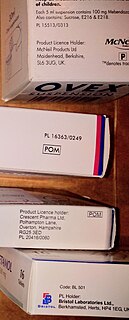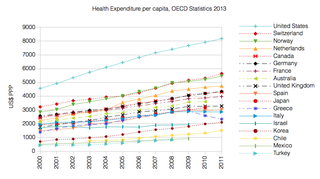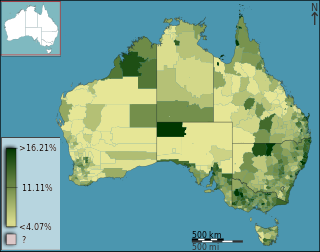Related Research Articles
Medicare is the publicly-funded universal health care insurance scheme in Australia, operated by the nation's social security department, Services Australia. Medicare is the principal way Australian citizens and permanent residents access most health care services in Australia. The scheme either partially or fully cover the cost of most primary health care services in the public and private health care system. All Australian citizens and permanent residents have access to fully covered health care in public hospitals, funded by Medicare, as well as state and federal contributions. International visitors from 11 countries have subsidised access to medically necessary treatment under reciprocal agreements.

A prescription drug is a pharmaceutical drug that legally requires a medical prescription to be dispensed. In contrast, over-the-counter drugs can be obtained without a prescription. The reason for this difference in substance control is the potential scope of misuse, from drug abuse to practicing medicine without a license and without sufficient education. Different jurisdictions have different definitions of what constitutes a prescription drug.
An orphan drug is a pharmaceutical agent developed to treat medical conditions which, because they are so rare, would not be profitable to produce without government assistance. The conditions are referred to as orphan diseases.

The National Institute for Health and Care Excellence (NICE) is an executive non-departmental public body of the Department of Health and Social Care in England that publishes guidelines in four areas:
The Pharmaceutical Benefits Scheme (PBS) is a program of the Australian Government that subsidises prescription medication for Australian citizens and permanent residents, as well as international visitors covered by a reciprocal health care agreement. The PBS is separate to the Medicare Benefits Schedule, a list of health care services that can be claimed under Medicare, Australia's universal health care insurance scheme.
Established in March 1998, NPS MedicineWise is an Australian not-for-profit organisation whose programs are funded by the national Department of Health. Since July 2012, the organisation has been officially known as NPS MedicineWise.

The healthcare in Switzerland is universal and is regulated by the Swiss Federal Law on Health Insurance. There are no free state-provided health services, but private health insurance is compulsory for all persons residing in Switzerland.
The Campaign for Access to Essential Medicines is an international campaign started by Médecins Sans Frontières (MSF) to increase the availability of essential medicines in developing countries. MSF often has difficulties treating patients because the medicines required are too expensive or are no longer produced. Sometimes, the only drugs available are highly toxic or ineffective, and they often have to resort to inadequate testing methods to diagnose patients.
Academic detailing is "university or non-commercial-based educational outreach." The process involves face-to-face education of prescribers by trained health care professionals, typically pharmacists, physicians, or nurses. The goal of academic detailing is to improve prescribing of targeted drugs to be consistent with medical evidence from randomized controlled trials, which ultimately improves patient care and can reduce health care costs. A key component of non-commercial or university-based academic detailing programs is that they do not have any financial links to the pharmaceutical industry.
Pharmaceutical policy is a branch of health policy that deals with the development, provision and use of medications within a health care system. It embraces drugs, biologics, vaccines and natural health products.
Protein-bound paclitaxel, also known as nanoparticle albumin–bound paclitaxel or nab-paclitaxel, is an injectable formulation of paclitaxel used to treat breast cancer, lung cancer and pancreatic cancer, among others. Paclitaxel kills cancer cells by preventing the normal breakdown of microtubules during cell division. In this formulation, paclitaxel is bonded to albumin as a delivery vehicle. It is manufactured and sold in the United States by Celgene under the trade name Abraxane where it is designated as an orphan drug as first-line treatment, in combination with gemcitabine, for the orphan disease "metastatic adenocarcinoma of the pancreas".

Health care in Australia operates under a shared public-private model underpinned by the Medicare system, the national single-payer funding model. State and territory governments operate public health facilities where eligible patients receive care free-of-charge. Primary health services, such as GP clinics, are privately owned in most situations, but attract Medicare rebates. Australian citizens, permanent residents, and some visitors and visa holders are eligible for health services under the Medicare system. Individuals are encouraged through tax surcharges to purchase health insurance to cover services offered in the private sector, and further fund health care.

Martin Paul Whitely, is a mental health researcher, author and was a Labor member of the Western Australian Legislative Assembly from February 2001 until he retired from state politics in March 2013. During his parliamentary and research career Whitely has been a prominent critic of increasing child mental health medication prescribing rates.
Medication costs, also known as drug costs are a common health care cost for many people and health care systems. Prescription costs are the costs to the end consumer. Medication costs are influenced by multiple factors such as patents, stakeholder influence, and marketing expenses. A number of countries including Canada, parts of Europe, and Brasil use external reference pricing as a means to compare drug prices and to determine a base price for a particular medication. Other countries use pharmacoeconomics, which looks at the cost/benefit of a product in terms of quality of life, alternative treatments, and cost reduction or avoidance in other parts of the health care system. Structures like the UK's National Institute for Health and Clinical Excellence and to a lesser extent Canada's Common Drug Review evaluate products in this way.
At its most basic level, a formulary is a list of medicines. Traditionally, a formulary contained a collection of formulas for the compounding and testing of medication. Today, the main function of a prescription formulary is to specify particular medications that are approved to be prescribed at a particular hospital, in a particular health system, or under a particular health insurance policy. The development of prescription formularies is based on evaluations of efficacy, safety, and cost-effectiveness of drugs.
Comparative effectiveness research (CER) is the direct comparison of existing health care interventions to determine which work best for which patients and which pose the greatest benefits and harms. The core question of comparative effectiveness research is which treatment works best, for whom, and under what circumstances. Engaging various stakeholders in this process, while difficult, makes research more applicable through providing information that improves patient decision making.
The Australian Pharmaceutical Advisory Council (APAC), active between 1996 and 2006, was "a consultative forum that brought together stakeholders from the medical, nursing and pharmacy professions, as well as industry, consumers and government, to advise the Australian Government Minister for Health and Ageing on medicines policy". In 1996 APAC contributed to the Industry Commission inquiry into the pharmaceutical industry. Over subsequent years the Council developed Australia's National Medicines Policy (NMP), and published several guidelines on medication management. Secretariat support for APAC was provided by the Australian Government Department of Health and Ageing - National Medicines Policy Strategies Section.
The Cancer Drugs Fund (CDF) was introduced in England in 2011. It was established in order to provide a means by which National Health Service (NHS) patients in England could get cancer drugs rejected by National Institute for Health and Care Excellence because they were not cost effective. Its establishment was confirmed by the UK government's coalition agreement in 2010, and by the White Paper, Equity and excellence – Liberating the NHS.
The Pharmaceutical Price Regulation Scheme (PPRS) is the mechanism used by the UK Department of Health to ensure that the NHS has access to good quality branded medicines at reasonable prices. It involves a non-contractual agreement between the UK Department of Health and The Association of the British Pharmaceutical Industry (ABPI). The scheme applies to all branded, licensed medicines available on the NHS. The purpose of the scheme is to achieve a balance between reasonable prices for the NHS and a fair return for the pharmaceutical industry.
The Institute for Clinical and Economic Review (ICER) is a Boston-based independent nonprofit organization that seeks to place a value on medical care by providing comprehensive clinical and cost-effectiveness analyses of treatments, tests, and procedures.
References
- ↑ Department of Health and Ageing – Quality Use of Medicines (2008). Available at http://www.health.gov.au/internet/main/publishing.nsf/Content/national-medicines-policydoc~national-medicines-policy-5 (accessed 6 November 2009).
- ↑ See http://www.health.gov.au/internet/main/publishing.nsf/Content/national-medicines-policydoc~national-medicines-policy-5.
- ↑ CHF Quality Use of Medicines Engagement in Moree (2009). Available at http://www.chf.org.au/pdfs/rep/rep-353-qum-engagement-moree.pdf (accessed 6 November 2009).
- ↑ Pfizer Australia, Quality Use of Medicines. Available at http://www.pfizer.com.au/Facts/QualityUse.aspx.
- ↑ Pharmaceutical Society of Australia, PSA Position Statement on Community Pharmacy Agreements (2009). Available at http://www.psa.org.au/site.php?id=4209.
- ↑ National Prescribing Service, Medicines Line. Available at http://nps.org.au/consumers/ask_an_expert/contact_a_pharmacist/medicines_line (accessed 6 November 2009).
- ↑ Commonwealth of Australia (2002). The National Strategy for Quality Use of Medicines. Page 34. Available at http://www.health.gov.au/internet/main/Publishing.nsf/Content/CA777524C860DFF2CA256F1800468B61/$File/natstrateng.pdf (accessed 6 November 2009).
- ↑ Gertskis, Mark (2009). “PBAC lauded for cost-effectiveness”. Pharmacy News, available at http://www.pharmacynews.com.au/article/pbac-lauded-for-cost-effectiveness/501162.aspx (accessed 6 November 2009).